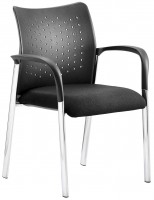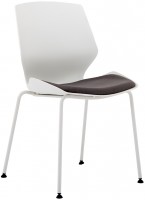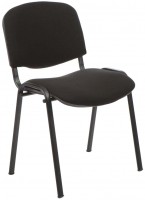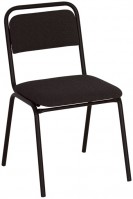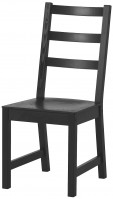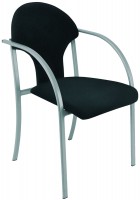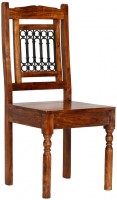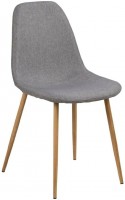Chairs King Home
All Chairs Advanced filters → |
You might be interested in
Chairs: specifications, types
Features
The purpose determines the main features of the design and, accordingly, the use of the chair.
- Classic. Chairs have a traditional, most standard design - in the form of a seat with a back. Such products differ from armchair chairs in the absence of armrests, from stools - in the presence of a back, and from bar stools - primarily in height (in this case it is small, the feet of the seated person are on the ground). At the same time, classic models are very diverse in style and comfort.
— Chair-chair. Chairs of increased comfort, the distinctive feature of which is the presence of palm rests (see below). However, “comfort” in this case is a rather relative concept: some models are only slightly short of full-fledged soft chairs, while others have hard seats and purely symbolic armrests.
— Folding. Chairs (usually in a classic format, see above) with a folding design. When folded, the legs and seat usually rotate so that the entire structure becomes flat; this makes storage and transportation much easier. On the other hand, in terms of comfort, folding chairs are usually inferior to non-folding ones, and their reliability is noticeably lower. Therefore, it makes sense to pay attention to this option in cases where the ability to compactly fold furniture is more important than strength and convenience. In particular, folding chairs can be us...eful when organizing outdoor events (although for long stays in nature it is better to use special tourist furniture).
- Bar. Chairs designed for sitting at a bar counter or other similar furniture (for example, a high reception desk). The common features of almost all bar stools are their high height and the presence of a footrest - resting your feet on the ground while sitting on a high seat is uncomfortable, if not impossible. But the design of the seat can be different: there are bar stools in the form of stools (see below), in the form of chairs with a back, with armrests, etc.
- Half-bar. A kind of transitional link between high bar stools and traditional dining stools. These chairs differ from their original bar counterparts in their reduced height (about 60-70 cm). Their main habitat is the home kitchen with a bar counter no more than 1 meter in height. Also, half-bar stools often lack a footrest.
— Stool. Stools are the simplest type of chairs - a seat on legs, without any backs or armrests. Such furniture is not very comfortable and is rather poorly suited for long-term sitting; on the other hand, it is simple, inexpensive and quite compact. In addition, on a stool you can easily turn your face in any direction, which in some situations can be useful.
- Classic. Chairs have a traditional, most standard design - in the form of a seat with a back. Such products differ from armchair chairs in the absence of armrests, from stools - in the presence of a back, and from bar stools - primarily in height (in this case it is small, the feet of the seated person are on the ground). At the same time, classic models are very diverse in style and comfort.
— Chair-chair. Chairs of increased comfort, the distinctive feature of which is the presence of palm rests (see below). However, “comfort” in this case is a rather relative concept: some models are only slightly short of full-fledged soft chairs, while others have hard seats and purely symbolic armrests.
— Folding. Chairs (usually in a classic format, see above) with a folding design. When folded, the legs and seat usually rotate so that the entire structure becomes flat; this makes storage and transportation much easier. On the other hand, in terms of comfort, folding chairs are usually inferior to non-folding ones, and their reliability is noticeably lower. Therefore, it makes sense to pay attention to this option in cases where the ability to compactly fold furniture is more important than strength and convenience. In particular, folding chairs can be us...eful when organizing outdoor events (although for long stays in nature it is better to use special tourist furniture).
- Bar. Chairs designed for sitting at a bar counter or other similar furniture (for example, a high reception desk). The common features of almost all bar stools are their high height and the presence of a footrest - resting your feet on the ground while sitting on a high seat is uncomfortable, if not impossible. But the design of the seat can be different: there are bar stools in the form of stools (see below), in the form of chairs with a back, with armrests, etc.
- Half-bar. A kind of transitional link between high bar stools and traditional dining stools. These chairs differ from their original bar counterparts in their reduced height (about 60-70 cm). Their main habitat is the home kitchen with a bar counter no more than 1 meter in height. Also, half-bar stools often lack a footrest.
— Stool. Stools are the simplest type of chairs - a seat on legs, without any backs or armrests. Such furniture is not very comfortable and is rather poorly suited for long-term sitting; on the other hand, it is simple, inexpensive and quite compact. In addition, on a stool you can easily turn your face in any direction, which in some situations can be useful.
Seat shape
The general shape of the seat provided in the product.
— Round. Round seats are popular among stools and bar stools (see "Purpose"), although they are also found in classic models. Usually we are talking about a round shape, without any frills.
— Square. The square shape is quite common among classic chairs (see Purpose); in other varieties, it is used less frequently, although it also occurs. Such a seat gives a little more space than a round one, which in some situations is an advantage — for example, with a large physique of the person sitting. Note that the name "square" is rather conditional, because. the specific shape may differ from the classic square: for example, seats are very popular, where the two back corners are rounded.
— Cocoon. Seats of this type are made in the form of a characteristic bowl with a recess. At the same time, in many models, the edges of the bowl have a rather large height, playing the role of a back and armrests (there are also cocoons with only a back, without rests for hands). Anyway, such a monolithic design not only gives the product an original appearance, but also provides additional strength.
— Round. Round seats are popular among stools and bar stools (see "Purpose"), although they are also found in classic models. Usually we are talking about a round shape, without any frills.
— Square. The square shape is quite common among classic chairs (see Purpose); in other varieties, it is used less frequently, although it also occurs. Such a seat gives a little more space than a round one, which in some situations is an advantage — for example, with a large physique of the person sitting. Note that the name "square" is rather conditional, because. the specific shape may differ from the classic square: for example, seats are very popular, where the two back corners are rounded.
— Cocoon. Seats of this type are made in the form of a characteristic bowl with a recess. At the same time, in many models, the edges of the bowl have a rather large height, playing the role of a back and armrests (there are also cocoons with only a back, without rests for hands). Anyway, such a monolithic design not only gives the product an original appearance, but also provides additional strength.
Seat material
The material used as the base of the seat.
— Tree. "Classic of the genre", not losing popularity nowadays. Wood looks good and is pleasant to the touch, and although it is inferior in strength to metal, nevertheless, it can be used to create fairly reliable furniture at quite reasonable prices. At the same time, this material is quite suitable for expensive products, including designer ones: there are many valuable types of wood. Most often, wooden products (regardless of the price category) are designed for retro, country and similar furnishings.
— Metal. The main advantages of metal can be called high strength, reliability and durability. Such furniture most often looks technological and “cold”, it is designed mainly for utilitarian use and interiors in modern or high-tech style. However, there are exceptions — metal chairs are produced with a fairly rich design, suitable for artsy environments.
— Plastic. Many consider plastic a low-cost material with a low cost and modest strength characteristics; however, this is not entirely true in the case of chairs. The fact is that there are many varieties of plastic on the market, differing in price and quality; so the strength, reliability and durability of the plastic seat directly depends on the overall price category of the product. Of the unequivocal advantages of this material, it is worth noting that it can have any colour...and even coloring — moreover, “by itself”, without the use of additional coatings. However most plastic surfaces scratch quite easily; but this only affects the general appearance of the chair and does not affect its working properties.
— Tree. "Classic of the genre", not losing popularity nowadays. Wood looks good and is pleasant to the touch, and although it is inferior in strength to metal, nevertheless, it can be used to create fairly reliable furniture at quite reasonable prices. At the same time, this material is quite suitable for expensive products, including designer ones: there are many valuable types of wood. Most often, wooden products (regardless of the price category) are designed for retro, country and similar furnishings.
— Metal. The main advantages of metal can be called high strength, reliability and durability. Such furniture most often looks technological and “cold”, it is designed mainly for utilitarian use and interiors in modern or high-tech style. However, there are exceptions — metal chairs are produced with a fairly rich design, suitable for artsy environments.
— Plastic. Many consider plastic a low-cost material with a low cost and modest strength characteristics; however, this is not entirely true in the case of chairs. The fact is that there are many varieties of plastic on the market, differing in price and quality; so the strength, reliability and durability of the plastic seat directly depends on the overall price category of the product. Of the unequivocal advantages of this material, it is worth noting that it can have any colour...and even coloring — moreover, “by itself”, without the use of additional coatings. However most plastic surfaces scratch quite easily; but this only affects the general appearance of the chair and does not affect its working properties.
Seat upholstery
Seat upholstery material.
— Fabric. Quite popular modern material for upholstery. The fabric can vary in composition (natural, synthetic, combined), have different density, texture, colour and pattern, which allows you to provide options for almost every taste. Such upholstery is generally pleasant to the touch, in most cases it does not wear out, does not require special care (unlike leather) and is generally inexpensive. Among the shortcomings, it is worth noting the sensitivity to pollution: liquids are easily absorbed into the fabric, and removing stains from it can be quite difficult. However, this shortcoming can hardly be classified as critical.
— Leatherette. Synthetic material that imitates natural leather to a certain extent. The degree of similarity can be different, depending on the price category and the overall quality of leatherette: inexpensive varieties are similar only “from afar”, advanced ones can be almost indistinguishable even by touch. The main advantage of this material over leather is its low cost; in addition, it does not require special care. On the other hand, leatherette is less durable and wears out faster; however, here everything, again, is highly dependent on the price category and the overall quality of the material.
— Fabric or leatherette. This option means that the product is available in two upholstery options — fabric or leatherette....See above for details on each of these materials.
— Skin. Genuine leather is considered a premium material: it is not cheap, but it gives the furniture a solid appearance that emphasizes the overall richness of the situation. To the touch, this material is pleasant to most users, but there are exceptions (some feel that the skin is “sticky”). Leather products are quite durable, but they may require special treatment to prevent drying and cracking.
— Fabric. Quite popular modern material for upholstery. The fabric can vary in composition (natural, synthetic, combined), have different density, texture, colour and pattern, which allows you to provide options for almost every taste. Such upholstery is generally pleasant to the touch, in most cases it does not wear out, does not require special care (unlike leather) and is generally inexpensive. Among the shortcomings, it is worth noting the sensitivity to pollution: liquids are easily absorbed into the fabric, and removing stains from it can be quite difficult. However, this shortcoming can hardly be classified as critical.
— Leatherette. Synthetic material that imitates natural leather to a certain extent. The degree of similarity can be different, depending on the price category and the overall quality of leatherette: inexpensive varieties are similar only “from afar”, advanced ones can be almost indistinguishable even by touch. The main advantage of this material over leather is its low cost; in addition, it does not require special care. On the other hand, leatherette is less durable and wears out faster; however, here everything, again, is highly dependent on the price category and the overall quality of the material.
— Fabric or leatherette. This option means that the product is available in two upholstery options — fabric or leatherette....See above for details on each of these materials.
— Skin. Genuine leather is considered a premium material: it is not cheap, but it gives the furniture a solid appearance that emphasizes the overall richness of the situation. To the touch, this material is pleasant to most users, but there are exceptions (some feel that the skin is “sticky”). Leather products are quite durable, but they may require special treatment to prevent drying and cracking.
Seat height
Seat height from the ground. In most modern chairs and stools, this height is 48 - 50 cm - this value is considered suitable for adults of almost any physique. Bar stools are often made taller - up to 90 cm or even more; this is due to the specifics of the application. Such products can be height adjustable.
Back
The type of back provided in the design of the chair.
— Solid (closed). Classic solid mid-height back. Such a backrest will provide reliable support regardless of where the user's back contacts it; this is the main advantage over the semi-closed and open design. On the other hand, solid backs are not well ventilated, which can be uncomfortable in hot weather.
— Solid elongated. A variation of the solid backs described above, which has an increased overall length — more precisely, height. Usually the back is made elongated downwards, so that it protrudes somewhat below the seat. This design somewhat increases the reliability of the product, and it looks original. But from the point of view of convenience, elongated backs do not have any special advantages over “ordinary” solid ones: the working height (height from the seat) is approximately the same for both.
— Open. The back is in the form of a kind of frame: a U-shaped base in which a set of rods is installed (vertical, horizontal, figured — the design may be different in different models). It is unlikely that you will be able to lean back on such a back with particular convenience, but it provides excellent back ventilation, which is especially valuable in the heat.
— Semi closed. A kind of middle option between the closed and open backs descr...ibed above. In the classic version, the upper part of such a back has the form of a solid plate, on which the back rests, while the lower part is made in the form of a frame. This ensures both ventilation and back support where you need it most. However, there are other options for semi-closed backs — for example, a high design with a narrow vertical slot, a solid back with a small hole in the lumbar region, etc.
— Solid (closed). Classic solid mid-height back. Such a backrest will provide reliable support regardless of where the user's back contacts it; this is the main advantage over the semi-closed and open design. On the other hand, solid backs are not well ventilated, which can be uncomfortable in hot weather.
— Solid elongated. A variation of the solid backs described above, which has an increased overall length — more precisely, height. Usually the back is made elongated downwards, so that it protrudes somewhat below the seat. This design somewhat increases the reliability of the product, and it looks original. But from the point of view of convenience, elongated backs do not have any special advantages over “ordinary” solid ones: the working height (height from the seat) is approximately the same for both.
— Open. The back is in the form of a kind of frame: a U-shaped base in which a set of rods is installed (vertical, horizontal, figured — the design may be different in different models). It is unlikely that you will be able to lean back on such a back with particular convenience, but it provides excellent back ventilation, which is especially valuable in the heat.
— Semi closed. A kind of middle option between the closed and open backs descr...ibed above. In the classic version, the upper part of such a back has the form of a solid plate, on which the back rests, while the lower part is made in the form of a frame. This ensures both ventilation and back support where you need it most. However, there are other options for semi-closed backs — for example, a high design with a narrow vertical slot, a solid back with a small hole in the lumbar region, etc.
Back upholstery
The material used for the upholstery of the back (if any).
— Fabric. Quite popular modern material for upholstery. The fabric can vary in composition (natural, synthetic, combined), have different density, texture, colour and pattern, which allows you to choose an option for almost every taste. Such upholstery is generally pleasant to the touch, does not wash off (unlike leatherette), does not require special care (unlike leather) and is generally inexpensive. Among the shortcomings, it is worth noting the sensitivity to liquid contaminants: liquids are easily absorbed into the fabric and stains appear on it, which can be quite difficult to remove. However, this shortcoming can hardly be classified as critical.
— Leatherette. Synthetic material that imitates natural leather to a certain extent. The degree of such similarity can be different, depending on the price category and the overall quality of leatherette: inexpensive varieties are similar only “from afar”, advanced types can be almost indistinguishable even by touch. The main advantage of this material over leather is its low cost; in addition, it does not require special care. On the other hand, leatherette is less durable and wears out faster; however, here everything, again, is highly dependent on the price category and the overall quality of the material.
— Fabric or leatherette. This option means that the produc...t is available in two upholstery options — fabric or leatherette. See above for details on each of these materials.
— Skin. Genuine leather is considered a premium material: it is not cheap, but it gives the furniture a solid appearance that emphasizes the overall richness of the situation. To the touch, this material is pleasant to most users, but there are exceptions (some feel that the skin is “sticky”). Leather products are quite durable, but they may require special treatment to prevent drying and cracking.
Note that there are quite a few models where the back has no upholstery at all. The material of the back, usually, corresponds to the material of the seat (see above).
— Fabric. Quite popular modern material for upholstery. The fabric can vary in composition (natural, synthetic, combined), have different density, texture, colour and pattern, which allows you to choose an option for almost every taste. Such upholstery is generally pleasant to the touch, does not wash off (unlike leatherette), does not require special care (unlike leather) and is generally inexpensive. Among the shortcomings, it is worth noting the sensitivity to liquid contaminants: liquids are easily absorbed into the fabric and stains appear on it, which can be quite difficult to remove. However, this shortcoming can hardly be classified as critical.
— Leatherette. Synthetic material that imitates natural leather to a certain extent. The degree of such similarity can be different, depending on the price category and the overall quality of leatherette: inexpensive varieties are similar only “from afar”, advanced types can be almost indistinguishable even by touch. The main advantage of this material over leather is its low cost; in addition, it does not require special care. On the other hand, leatherette is less durable and wears out faster; however, here everything, again, is highly dependent on the price category and the overall quality of the material.
— Fabric or leatherette. This option means that the produc...t is available in two upholstery options — fabric or leatherette. See above for details on each of these materials.
— Skin. Genuine leather is considered a premium material: it is not cheap, but it gives the furniture a solid appearance that emphasizes the overall richness of the situation. To the touch, this material is pleasant to most users, but there are exceptions (some feel that the skin is “sticky”). Leather products are quite durable, but they may require special treatment to prevent drying and cracking.
Note that there are quite a few models where the back has no upholstery at all. The material of the back, usually, corresponds to the material of the seat (see above).
Back height
The height of the back of the chair relative to the seat. In modern chairs, this height is most often not particularly large — from 30 to 60 cm. At the same time, backs less than 40 cm high are actually purely symbolic — they provide almost no support for the back. An indicator of 40 – 50 cm is average, and a person of average height can lean on the back of more than 50 cm with almost his entire back.
Support
The design of the chair base – the support with which it stands on the floor.
– Straight legs. Classic vertical legs. They can be either strictly straight or different from it – for example, in some chairs, the back legs may have an additional slope or bend for greater stability. The legs are straight if the deviation from the vertical or straight shape is small. In any case, this option is the most popular in modern chairs – thanks to a combination of simplicity, reliability and aesthetics. Also note that the legs are better suited for uneven floors than sled base or round base: three legs will have support in any case, and something can be placed under the fourth if necessary.
– Angled legs. Legs set at a clear slope to the vertical. Usually such legs are inclined in such a way that the base expands downwards. This provides an original appearance and at the same time sufficient footprint. At the same time, this design does not have obvious advantages over straight legs, and therefore is much less common.
– Sled base. The basis in the form of horizontal sled. Most often, in such models, the part of the base that is in contact with the floor has the shape of the letter “U”, turned with its legs forward; and the seat is connected to the base by two vertical uprights at the front, giving the impression that the back of the chair is actually h...anging in the air. However, this impression is deceptive – the design of the product provides the necessary rigidity. Such chairs have an unusual appearance, besides, the space under the seat is open on three sides, which can be critical in cramped conditions. At the same time, the reliability of such structures is noticeably lower than that of models with classic legs; under heavy load, the base wears out rather quickly. Occasionally there are more traditional sled variant can be found – in the form of two parallel supports on the sides of the chair; in fact – the same legs, only connected in pairs at the bottom. Such designs are quite durable, but they do not have any special advantages over classic legs, so they are not widely used.
- Round base. The basis in the form of a flat disc with a vertical rack. Such a base has an interesting appearance, in addition, disc chairs are usually made to rotate. On the other hand, this option is more expensive than classic legs, while being somewhat inferior to them in terms of stability. It is also worth considering that to install a chair with a disc, you need a very flat floor – at the slightest irregularity, the structure will stagger. In light of this, this option is extremely rarely used in classic furniture, but it is popular in bar stools – it is for them that the rotating design is most relevant.
– Square base. Such bases can be made both in the form of a flat platform and in the form of horizontal sleds closed in a square. This option has become widespread in bar furniture. Note that to ensure proper stability, chairs with a square base must be installed on a flat floor – at the slightest uneven flooring, the structure will stagger.
– Cross. A support in the form of several horizontally arranged slats extending from one point in different directions. There are usually at least four such supports – this is quite enough to prevent the chair from tipping over. At the ends of the "beams" of the cross, decorative overlays are often installed so that the furniture does not slide on the floor and does not scratch the floor coverings.
– U-shaped. The base is in the form of flat horizontal sleds, laid out in the shape of the letter U. It is used in designer furniture with a non-trivial design style and provides the chair with good stability on flat surfaces. U-shaped support is an attribute of expensive models with an unusual appearance.
– Straight legs. Classic vertical legs. They can be either strictly straight or different from it – for example, in some chairs, the back legs may have an additional slope or bend for greater stability. The legs are straight if the deviation from the vertical or straight shape is small. In any case, this option is the most popular in modern chairs – thanks to a combination of simplicity, reliability and aesthetics. Also note that the legs are better suited for uneven floors than sled base or round base: three legs will have support in any case, and something can be placed under the fourth if necessary.
– Angled legs. Legs set at a clear slope to the vertical. Usually such legs are inclined in such a way that the base expands downwards. This provides an original appearance and at the same time sufficient footprint. At the same time, this design does not have obvious advantages over straight legs, and therefore is much less common.
– Sled base. The basis in the form of horizontal sled. Most often, in such models, the part of the base that is in contact with the floor has the shape of the letter “U”, turned with its legs forward; and the seat is connected to the base by two vertical uprights at the front, giving the impression that the back of the chair is actually h...anging in the air. However, this impression is deceptive – the design of the product provides the necessary rigidity. Such chairs have an unusual appearance, besides, the space under the seat is open on three sides, which can be critical in cramped conditions. At the same time, the reliability of such structures is noticeably lower than that of models with classic legs; under heavy load, the base wears out rather quickly. Occasionally there are more traditional sled variant can be found – in the form of two parallel supports on the sides of the chair; in fact – the same legs, only connected in pairs at the bottom. Such designs are quite durable, but they do not have any special advantages over classic legs, so they are not widely used.
- Round base. The basis in the form of a flat disc with a vertical rack. Such a base has an interesting appearance, in addition, disc chairs are usually made to rotate. On the other hand, this option is more expensive than classic legs, while being somewhat inferior to them in terms of stability. It is also worth considering that to install a chair with a disc, you need a very flat floor – at the slightest irregularity, the structure will stagger. In light of this, this option is extremely rarely used in classic furniture, but it is popular in bar stools – it is for them that the rotating design is most relevant.
– Square base. Such bases can be made both in the form of a flat platform and in the form of horizontal sleds closed in a square. This option has become widespread in bar furniture. Note that to ensure proper stability, chairs with a square base must be installed on a flat floor – at the slightest uneven flooring, the structure will stagger.
– Cross. A support in the form of several horizontally arranged slats extending from one point in different directions. There are usually at least four such supports – this is quite enough to prevent the chair from tipping over. At the ends of the "beams" of the cross, decorative overlays are often installed so that the furniture does not slide on the floor and does not scratch the floor coverings.
– U-shaped. The base is in the form of flat horizontal sleds, laid out in the shape of the letter U. It is used in designer furniture with a non-trivial design style and provides the chair with good stability on flat surfaces. U-shaped support is an attribute of expensive models with an unusual appearance.
Frame material
The material from which the frame of the base of the chair is made.
— Metal. The metal is highly durable and able to withstand even high loads. Of course, the quality of such a base will depend on the specific alloy; however, most often, reliable and durable steel is used in chairs. In addition, this material resists scratches very well (in the worst case, the paint may be scratched), and is not particularly expensive. Thanks to all this, it is metal bases that are most popular in modern chairs. And such types of supports, such as a disk or skids (see "Base"), are generally made only of metal — other materials are not strong enough for this.
— Tree. The tree has a rather pleasant appearance, especially appropriate for furniture in a classic design, as well as in country and retro styles. The strength of this material is average, in terms of reliability it is inferior to metal, but this moment can be compensated for by increasing the thickness of the frame. Because of this, wooden bases (usually in the form of traditional legs) are very popular in modern chairs.
— Plastic. Usually, special high-strength varieties of plastic are used for the bases, which allow you to create furniture with a high load capacity. Nevertheless, in terms of overall reliability, such materials are still inferior to wood, and even more so to metal; and the most dura...ble varieties of plastic cost so much that it is easier to use the same metal or wood. Therefore, plastic bases have not received much popularity.
— Metal. The metal is highly durable and able to withstand even high loads. Of course, the quality of such a base will depend on the specific alloy; however, most often, reliable and durable steel is used in chairs. In addition, this material resists scratches very well (in the worst case, the paint may be scratched), and is not particularly expensive. Thanks to all this, it is metal bases that are most popular in modern chairs. And such types of supports, such as a disk or skids (see "Base"), are generally made only of metal — other materials are not strong enough for this.
— Tree. The tree has a rather pleasant appearance, especially appropriate for furniture in a classic design, as well as in country and retro styles. The strength of this material is average, in terms of reliability it is inferior to metal, but this moment can be compensated for by increasing the thickness of the frame. Because of this, wooden bases (usually in the form of traditional legs) are very popular in modern chairs.
— Plastic. Usually, special high-strength varieties of plastic are used for the bases, which allow you to create furniture with a high load capacity. Nevertheless, in terms of overall reliability, such materials are still inferior to wood, and even more so to metal; and the most dura...ble varieties of plastic cost so much that it is easier to use the same metal or wood. Therefore, plastic bases have not received much popularity.
Footrest
The presence of its own footrest in the design of the product. Such equipment is provided in models with a seat height of 60 cm or more — in particular, in bar stools: it is difficult, if not impossible, to get your feet to the ground from such a chair, and a special stand is needed for convenience.
Palm rests
The presence in the design of the chair rests for hands — in other words, armrests. Such stops provide additional convenience, but limit the space on the seat; this can create inconvenience in some cases — for example, with a small seat and a large physique of the seated. Also note that the size of the armrests can be different — in some models they are purely symbolic.
Height adjustment
The ability to change the height of the chair, more precisely — the height of the seat. This function is found mainly in models with a support in the form of a disk (see "Base"), in particular, bar stools — such products have a vertical bar in their design, into which the adjustment mechanism can be easily integrated. A footrest is also often provided (see above), however, there are models without it — in them the adjustment is carried out in a relatively small range, which allows you to reach the ground with your feet.
Soft chair
In this case, soft chairs mean chairs having a seat with a soft filler; the back, if available, is most often also made soft. At the same time, the design can be quite far from classic armchairs — for example, some of these products are high bar stools with backs of symbolic height, others are simple stools. However, anyway, it makes sense to pay attention to models of this type for those who appreciate soft seats.
Retro design
Chairs made in retro design — "antique", often with a rather unusual and rich design. Note that such a design will not fit into every style of interior, and such chairs can cost much more than similar models in modern design. Therefore, it makes sense to pay attention to such products, first of all, if the entire room is initially designed in retro style (or if you are sure of style compatibility).
Chair height
The overall height of the chair is from the floor to the top. In models without backrest, this dimension actually corresponds to the height of the seat (see above). If there is a back, it determines the overall dimensions of the chair; this information is rarely required, mainly for storage or transport.
Max. load
The maximum allowable load for a given chair, in other words, the maximum weight that it can normally withstand.
Note that modern chairs usually have a margin of safety, and if the weight is exceeded, it is likely that the product will not break immediately. However, it is still impossible to allow such an excess: under an off-design load, the chair will wear out a lot, and a breakdown can occur at any time — including later, under a completely acceptable weight.
Note that modern chairs usually have a margin of safety, and if the weight is exceeded, it is likely that the product will not break immediately. However, it is still impossible to allow such an excess: under an off-design load, the chair will wear out a lot, and a breakdown can occur at any time — including later, under a completely acceptable weight.

